
Northmen Stadium Opens to Excitement, 'Awe'
September 1, 2016
By Dennis Chase
Special for Second Half
PETOSKEY – Petoskey kicked off a new era in football last Thursday with the unveiling of Northmen Stadium, a multi-use facility that will be home for football, soccer, lacrosse, band and track & field.
 More than 4,000 spectators turned out on a beautiful late August night to watch Petoskey open its season against Ada Forest Hills Eastern. School officials believe it was the largest home football crowd in Petoskey history.
More than 4,000 spectators turned out on a beautiful late August night to watch Petoskey open its season against Ada Forest Hills Eastern. School officials believe it was the largest home football crowd in Petoskey history.
Even a 35-14 setback could not dampen the enthusiasm and pride displayed by those in attendance.
“To see the stadium from the road is one thing – and that excited people,” Superintendent John Scholten said. “But once they got inside and saw it first-hand, there was an awe factor. It was like, ‘Wow!’”
Northmen Stadium replaces Curtis Field, which was built in 1927 and served as the home for Petoskey football for 88 years.
“Our community is very tradition-oriented, very values-oriented,” Dan Ledingham, president of the football boosters, said. “Curtis Field means a lot to us. It’s very symbolic – the roots from where we started. Multiple generations played on that field. I know families who go three to four generations deep. But it was time.”
“It’s time” was actually the theme for the $10 million bond proposal that the electorate approved by a 64 to 36 percent vote in 2014.
“It (Curtis Field) served the community well, but it was pretty tired,” Scholten said.
In addition to the $10 million bond, the school received significant donations and coordinated efforts with other sinking fund projects.
“The whole (campus) renovation is closer to $15 million,” Scholten said.
The project includes the stadium, reconstruction of six tennis courts, a rebuilt softball field, two new soccer practice fields, and a cross country 5K trail that ties into a community walkway and includes three culvert tunnels under realigned Northmen Drive.
It’s all part of a concerted effort to bring the school’s athletic facilities – once scattered around the city – to the campus location. The school had already built a stunning new high school gymnasium and an on-site baseball field.
“When I moved up here (from Maple City Glen Lake) two of the old icons from the Glen Lake days, Denny Dame and Ivan Ford, said you’re moving to the nicest gym in the north,” Scholten said. “I’m a little biased, but I think we now have one of the nicest football facilities in the north, too.”
 The stadium is the centerpiece of the latest project. The property’s topography featured a “semi-natural bowl” on the southeast side. Construction workers moved 300,000 cubic yards of dirt to build up the other side, creating a complete bowl appearance.
The stadium is the centerpiece of the latest project. The property’s topography featured a “semi-natural bowl” on the southeast side. Construction workers moved 300,000 cubic yards of dirt to build up the other side, creating a complete bowl appearance.
“The fact it sits down in a bowl makes it unique,” athletic director Dave Smith said. “There are lots of places that have nice stadiums, but they’re flat and the bleachers go up. With this, there’s not a bad seat in the house because it sits down in that bowl.”
The main entrance is near the mezzanine in the north end zone, which is where the concessions and restrooms are located. It features a plaza that overlooks the field. A tunnel runs underneath the mezzanine where the players and band enter and exit the field.
“It’s a very cool place to see a game,” football coach Kerry VanOrman said. “When the band marches through the tunnel, it’s like you’re at Michigan State or Michigan.”
Team rooms, a training room and an officials room are located off the tunnel.
A 40-foot video scoreboard anchors the south end zone. There’s also a messaging board attached to the mezzanine.
The synthetic turf is lined for football, soccer and lacrosse. The soccer team opens its home season Tuesday.
The stadium seats 2,950, but there is additional lawn seating on the hillside. Plus, based on opening night, fans seem to enjoy watching from the mezzanine.
“That elevation overlooking the field gives you the best view,” Ledingham said. “You can see everything, and you can feel the energy coming from the crowd.”
Workers scrambled to get the stadium ready for opening night. In fact, just 48 hours beforehand Ledingham wondered if it would be game ready.
 “There were tractors and trucks, concrete and tiles,” he said. “Everything was everywhere. It looked like a true construction site that maybe in a month would be close (to done). I was wondering, ‘What’s Plan B?’ Kent (Cartwright, the school’s chief financial officer) said, ‘There is no Plan B. We are on this field.’ It was neat to see it all come together.”
“There were tractors and trucks, concrete and tiles,” he said. “Everything was everywhere. It looked like a true construction site that maybe in a month would be close (to done). I was wondering, ‘What’s Plan B?’ Kent (Cartwright, the school’s chief financial officer) said, ‘There is no Plan B. We are on this field.’ It was neat to see it all come together.”
Smith agreed.
“It was unbelievable the number of people there, from the construction crew to the subcontractors, working extra hours, late hours, that last month to make sure we could get in there and play on that (Thursday),” he said. “Two days out, I was also wondering how this is going to happen. But it did.”
The school received a temporary occupancy permit to open the stadium. Finishing touches were still being completed this week.
The opening culminates nearly 10 years of work. A bond proposal to fund separate football and soccer stadiums was rejected by voters in 2007.
“We had a nice plan,” Scholten said, “but it was just when the recession was starting. We did all the pre-work with the surveys and it looked like the confidence was there, but when the economy went south, (the vote) went south, too.”
Officials regrouped and, after the lingering recession ended, pared back the plan and took it to the voters.
“It was unfortunate timing (in 2007),” VanOrman said. “They were smart in waiting for things to pick up. They did a good job planning it, locating it and even tying it into the city walkways. It kind of includes everybody into it.”
Officials changed the location of the stadium, building it on what was two practice fields so it could utilize existing locker rooms and showers at the school. Two additional locker rooms will be added.
“We listened to the community,” Scholten said. “We were a little extravagant (in 2007) so we came back with a different plan. We worked real hard to say, ‘We listened to you, we trimmed it back, we feel we’re being responsible.’ We worked hard to build that confidence back up.”
The cross country trail will facilitate skiers as well as runners and walkers. The new eight-lane track replaces the outdated six-lane version at Curtis Field.
“We couldn’t host anything big because of that,” Scholten said.
Scholten expects the new facility will make Petoskey an attractive choice for hosting MHSAA tournaments.
 Parking, an issue at Curtis Field, was addressed, too. Spectators can now use the high school and middle school lots, as well as new parking spaces near the stadium.
Parking, an issue at Curtis Field, was addressed, too. Spectators can now use the high school and middle school lots, as well as new parking spaces near the stadium.
The improvements now leave hockey and downhill skiing as the only sports played off campus, Smith said.
“From an athletic director’s standpoint, I love how most of our facilities are now on school grounds,” he said.
He also loves the positive buzz the stadium’s generated. Ledingham called opening night “surreal.”
“It was amazing to see our community come together to enjoy it,” he said.
The unveiling attracted fans from nearby communities as well.
“The energy and support was great,” junior kicker Noah Ledingham said. “You run on to that field, see the lights, see (the crowd) and it just makes you want to play harder.
“To be the first team to play on that field is an amazing feeling because it’s a new chapter (in Petoskey football) and you know you’re making history.”
The Northmen, with just two key returnees back, struggled early, falling behind Forest Hills Eastern 28-0 before rallying to make it a game.
“I was pleased with the way we played in the second half,” VanOrman said. “It was 28-14 with 3:30 left in the game. We went for an onside kick and it blew up in our face. They recovered and ran it back to our 15 and then scored. (Eastern’s) a good football team. It was a good measuring stick for us to see where we have to get better.”
The night might also pay dividends. Forest Hills Eastern officials are talking about extending the two-year deal with Petoskey that is set to expire after the Northmen travel down there next season.
“They liked it so much they want to come back in two years,” Smith said. “I would say that’s a compliment right there.”
 Dennis Chase worked 32 years as a sportswriter at the Traverse City Record-Eagle, including as sports editor from 2000-14. He can be reached at [email protected] with story ideas for Manistee, Wexford, Missaukee, Roscommon, Ogemaw, Iosco, Alcona, Oscoda, Crawford, Kalkaska, Grand Traverse, Benzie, Leelanau, Antrim, Otsego, Montmorency, Alpena, Presque Isle, Cheboygan, Charlevoix and Emmet counties.
Dennis Chase worked 32 years as a sportswriter at the Traverse City Record-Eagle, including as sports editor from 2000-14. He can be reached at [email protected] with story ideas for Manistee, Wexford, Missaukee, Roscommon, Ogemaw, Iosco, Alcona, Oscoda, Crawford, Kalkaska, Grand Traverse, Benzie, Leelanau, Antrim, Otsego, Montmorency, Alpena, Presque Isle, Cheboygan, Charlevoix and Emmet counties.
PHOTOS: (Top) Petoskey's stadium, at dusk, hosted Ada Forest Hills Eastern for its debut. (Middle above) The Northmen take to their new field for the first time. (Middle below) Fans packed the home stands, which are part of a "bowl" circling the playing surface. (Below) The new football field is just one part of the renovated Petoskey athletic complex. (Aerial photos by Charles Dawley/Up North Imaging. Game photos by Scott Moore.)
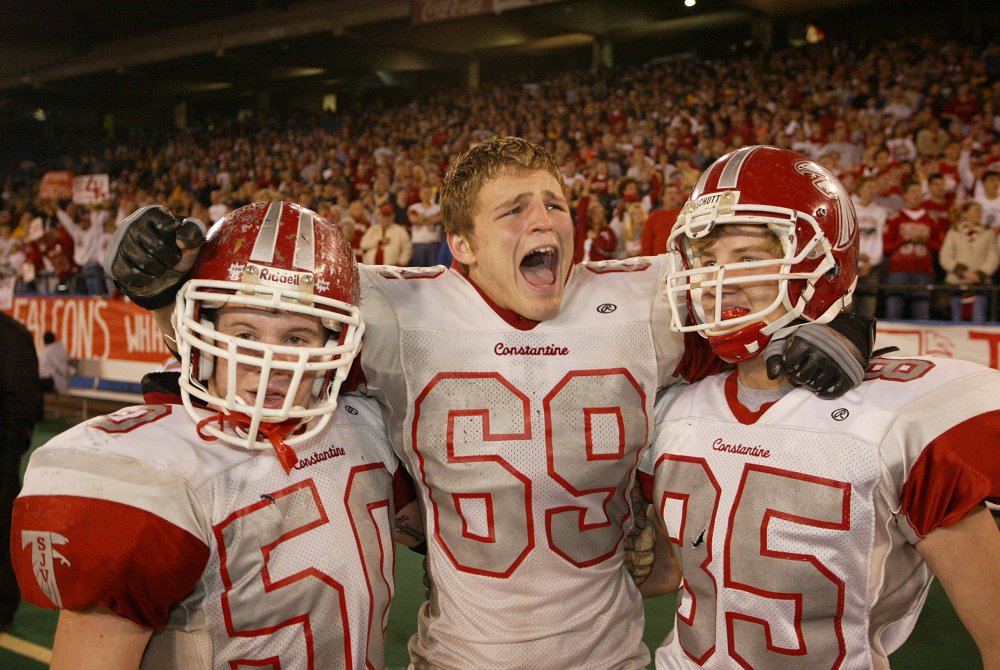
Constantine Celebrates 100th Season, Renowned for Continuity & Signature Wing-T
By
Scott Hassinger
Special for MHSAA.com
September 6, 2023
CONSTANTINE – Bennett Vandenberg and Cohen McGee are just like any other high school football players.
 Both Constantine seniors have high aspirations of winning a fifth-straight Southwestern Athletic Conference Lakeshore title and reaching the postseason.
Both Constantine seniors have high aspirations of winning a fifth-straight Southwestern Athletic Conference Lakeshore title and reaching the postseason.
But Vandenberg and McGee, along with their Falcons teammates, will be celebrating more than victories and a potential playoff appearance this fall.
Constantine, a community located in southern St. Joseph County, is observing the 100th season of the school's football program.
The Falcons (1-1) will commemorate the occasion Saturday, Oct. 7, with a home game against SAC Lakeshore foe Kalamazoo United. Kickoff time from Sweetland Stadium is 1 p.m. The game will be followed by a community luncheon and program in the high school at which time past coaches, players and the program's biggest accomplishments will be recognized and celebrated.
Vandenberg, a starting fullback/tight end and outside linebacker, and McGee, an offensive lineman and linebacker, are both looking forward to the rest of the season and continuing Constantine's strong tradition on the gridiron.
"We have a huge football tradition here at Constantine. This year we're celebrating the 100th year, and we have some of the oldest living players coming back to help celebrate after that game with United,” said Vandenberg, a three-year starter and Finals placer his junior year in wrestling and track & field. “Our community is all about football. We know we have to go out there and represent our school and community the right way."
McGee is following in the footsteps of his older brother Carter.
"There are lots of things that people who follow Constantine football don't see, like the hours of dedication and work we put in during the offseason. That's where we make our strides and become better as a program," McGee said.
The football stadium at Constantine is named after Dr. George Sweetland, a physician in the community, who donated money for a football stadium to be built with a hill completely circling the facility.
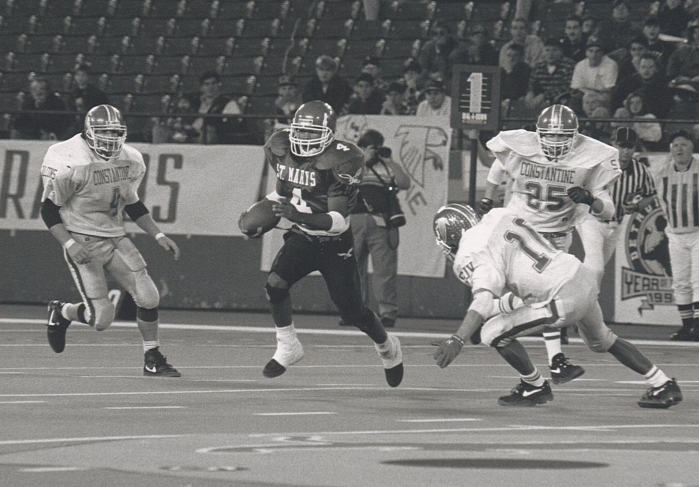 Sweetland, who moved to Constantine in 1916 to take over his brother's medical practice after the latter was killed in a car crash, reportedly allowed patients to work off their medical bills by helping with the stadium's construction.
Sweetland, who moved to Constantine in 1916 to take over his brother's medical practice after the latter was killed in a car crash, reportedly allowed patients to work off their medical bills by helping with the stadium's construction.
Constantine, which played its first football game in 1924 and finished as county champs at 4-2 under coach Lew Lake, sports an all-time record of 481 wins and 221 losses with 11 ties. During that span, the Falcons have enjoyed 11 unbeaten seasons, including Robert Finlay's 1937 squad that went 8-0 and was unscored upon.
Coaching longevity is one of the biggest factors allowing Constantine to be as successful as it has been, especially during the program's modern era. The Falcons have had just four head coaches since 1964.
Mike Messner, a three-sport athlete and 1965 Constantine graduate, later served as the school's athletic director from 1992-2016.
Messner pointed to Meredith 'Spud' Huston, Constantine's football coach from 1958-1961, as one of the first individuals influential in setting the wheels in motion for the program's future success.
Huston guided the Falcons to their first league title in 1961.
Constantine's four winningest coaches – Dave Horn, Tim Baker, Ken Rimer and Shawn Griffith – are all honorary members of the Michigan High School Football Coaches Association's Hall of Fame.
Horn, who died earlier this summer, served two stints as Constantine's head coach from 1964-1981 and 1987-1989 while compiling a 116-65-4 record.
Baker (129-30) coached Constantine for 15 seasons and guided the Falcons to a record of 129-30. Under Baker, the Falcons were Division 6 champs in 2004 and Finals runners-up in 1994 (Class CC) and 2002 (Division 5).
"Dave (Horn) was a genuinely great person who coached 21 years. He could get upset at you on the field, but he was a very kind, storyteller and a thoughtful guy who really cared about others," Messner said.
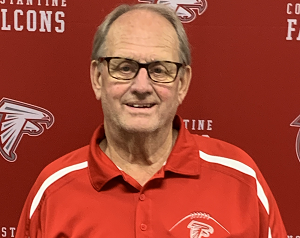 "In the modern coaching era, Tim (Baker) really believed in lifting weights, making kids stronger and developing kids into good football players. He was diligent, hardworking and put a lot of time into the program while missing a lot of family functions. He concentrated on doing the best job he could. Ken (Rimer) was right there in the same mode as Tim. When they started coaching together, they wanted a program that kids at Constantine could be proud of. Things started really happening, and ever since then the program has been strong. We have coaches who want Constantine to be successful on the field."
"In the modern coaching era, Tim (Baker) really believed in lifting weights, making kids stronger and developing kids into good football players. He was diligent, hardworking and put a lot of time into the program while missing a lot of family functions. He concentrated on doing the best job he could. Ken (Rimer) was right there in the same mode as Tim. When they started coaching together, they wanted a program that kids at Constantine could be proud of. Things started really happening, and ever since then the program has been strong. We have coaches who want Constantine to be successful on the field."
Rimer spent 28 years as an assistant coach under Baker and current head coach Shawn Griffith. Constantine compiled a win-loss mark of 242-70 with Rimer as an assistant.
Griffith, who took over as Constantine's head coach in 2005, is the Falcons’ all-time winningest coach at 156-53. Under Griffith's tutelage, the Falcons have made 17 playoff appearances, with back-to-back Division 6 runners-up finishes in 2011 and 2012.
"The history of Constantine football kind've coincides with everything else here in the community. This is my 32nd year overall as a coach in this program. But I also have several memories from when I was in high school at Mendon as a player going up against Constantine," Griffith said.
"When you talk about any community our size, you immediately look at family names. We have another Stears (Lucas) on this year's team. Mike (Messner) told me there have been over 20 from the Stears family that have worn the Falcon uniform. It doesn't stop there. I look at the number of kids we have in the locker room this year, and I realize that I've coached many of their brothers, fathers and uncles. We look at the program as one big family. This program has helped to raise a lot of young men in the area these last few years. The community has been extremely supportive of the program as well."
Constantine won 19 league championships as a member of the St. Joseph Valley League from 1952-2007. That league consisted of Constantine, White Pigeon, Schoolcraft, Centreville, Colon, Climax-Scotts, Burr Oak and Mendon. Bronson and Battle Creek St. Philip became members later after Climax-Scotts and Burr Oak left to join the Southern Central Athletic Association. Eventually, the SJV disbanded due to conference realignment and declining enrollment among its smaller schools.
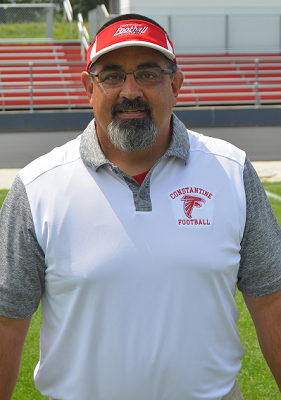 At one time, Constantine played in one of the longest-running rivalries in state football history. The Falcons and archrival White Pigeon began playing one another in 1924 and Constantine held a 47-35-6 in the rivalry, with wins in the final 17 meetings before the series ended after the 2007 season.
At one time, Constantine played in one of the longest-running rivalries in state football history. The Falcons and archrival White Pigeon began playing one another in 1924 and Constantine held a 47-35-6 in the rivalry, with wins in the final 17 meetings before the series ended after the 2007 season.
Messner recalls the 1981 meeting between White Pigeon and Constantine as one of the most memorable. The game was played at the Sweetland Stadium in Constantine, and there were more than 5,000 people in attendance.
"White Pigeon came into that game unscored upon and ranked No. 1 in the state. We were undefeated, but nobody was saying anything about us, but they were really talking (White Pigeon) up," Messner said. "(White Pigeon) had brought over 1,000 balloons with them and hid them behind the bleachers. They were going to launch them every time they scored. They never scored, and we beat them 21-0. It was such a sad moment for both schools when they had to stop playing one another in football."
After the SJV dissolved, Constantine and Schoolcraft became members of the Kalamazoo Valley Athletic Association from 2008-2014 before leaving to join the Southwestern Athletic Conference for the 2015 season. Constantine begins its ninth season competing in the SAC Lakeshore against the likes of Watervliet, Allegan, Kalamazoo United, South Haven and Parchment.
Messner also lists several playoff games as big moments in Constantine's football history.
"Our first playoff team (1991) was a big year, and our first state finals appearance (1994) was another," Messner added.
Constantine lost to Orchard Lake St. Mary's (35-7) in the 1994 Class CC Final, but knocked off heavily-favored Fennville (50-0) in their Pre-Regional and Whittemore-Prescott (54-6) in a Semifinal to get there.
"Both teams were considerably bigger than us up front on the line. Fennville had a really good quarterback (Frank Alfieri) and Whittemore-Prescott had a great tailback (Tom 'Touchdown' Tyson) that our much smaller guys managed to shut down," Messner said. "Then there was a 13-7 win we had in the 2002 Regional Finals over heavily-favored Muskegon Oakridge."
But perhaps the 2004 Semifinal deemed 'The Miracle in Marshall' will go down as the most memorable game in Constantine history. In that contest, Constantine trailed Monroe St. Mary Catholic Central 27-14 with a little more than six and a half minutes to go in the fourth quarter.
The Falcons scored twice during those last few minutes, including a last-second 32-yard TD pass from Aaron Baker to Sean Wolf caught in the end zone that tied the game at 27-27 with one second left. Jordan Williams booted the PAT as time expired, giving the Falcons a 28-27 win.
Constantine went on to defeat Suttons Bay 34-13 in the Division 6 Final the following week.
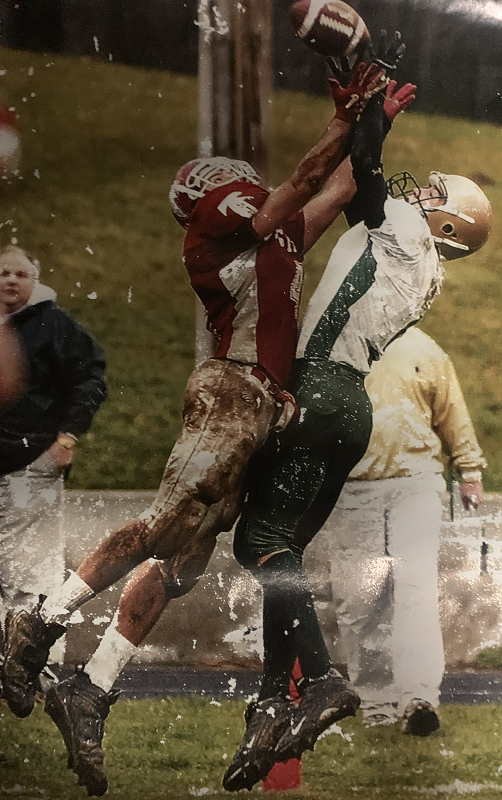 From 1991-2015, Constantine attained at least seven wins for 25 consecutive years, which is a state record. The Falcons made 18 consecutive playoff appearances from 1999-2016 before suffering their most recent losing season in 2017, when they finished 3-6.
From 1991-2015, Constantine attained at least seven wins for 25 consecutive years, which is a state record. The Falcons made 18 consecutive playoff appearances from 1999-2016 before suffering their most recent losing season in 2017, when they finished 3-6.
Constantine's overall playoff record stands at 49-25 with 26 total appearances.
It was Griffith, who played his high school football at Mendon for Class D championship-winning coach Roger Smith and his then-assistant John Schwartz (who would later lead the Hornets to 10 more Finals titles) who convinced Baker the Falcons should transition from the I-Formation to the Wing-T offense.
After much discussion and argument among the coaching staff, Baker reluctantly agreed to Griffith's idea.
"I joined the coaching staff in 1992 as offensive coordinator. As a coaching staff, we really came into our own and made our first run to the Finals in 1994. In the late ’90s we had some really good teams, but still didn't quite have a real identity. During that time we ran into some really good Wing-T football teams," Griffith said.
"We started noticing that we had a real hard time stopping these teams that ran the Wing-T like Muskegon Orchard View, Hopkins and Battle Creek Pennfield. So I came to Tim (Baker) after the 2001 season with the idea of changing the offense. We knew we had a tremendous group of running backs coming up through the program for the next seven or eight years. I approached him about running the Wing-T. He wasn't real receptive at first about running it. But after sitting down with other Wing-T coaches like John Shilito (Muskegon Orchard View) and Irv Sigler (Belding), he agreed to give it a try."
Constantine began running the Wing-T at the start of the 2002 season.
"Once you get known for running an offense like this, it kind've becomes your niche. I get emails from people all over the United States wanting me to come teach them this offense at camps. Here at Constantine, we've been fortunate to rack up quite a few wins since we installed this offense. Our kids can really talk the Wing-T game, and we didn't really have that before when we were running our I-formation and single-back stuff," Griffith said.
"The blocking schemes have become ingrained in our kids. They do a great job of knowing where they are supposed to be and who they are supposed to block. Another thing I really like about the Wing-T is it's a lineman's offense. Our linemen get a lot of credit, which they deserve. There is a certain toughness to this offense as well. It's allowed us to use kids who might be smaller and less athletic, but still allows us to be successful because they have developed a certain toughness."
Griffith credits a lot of that toughness to his players who compete on the Falcons' wrestling team during the winter sports season. Constantine’s wrestling program also has enjoyed a long run of success, including a Class C-D title in 1993 and Division 3 runner-up finish in 2002. The Falcons have won Team Regional titles three straight seasons.
 Scott Hassinger is a contributing sportswriter for Leader Publications and previously served as the sports editor for the Three Rivers Commercial-News from 1994-2022. He can be reached at [email protected] with story ideas for Berrien, Cass, St. Joseph and Branch counties.
Scott Hassinger is a contributing sportswriter for Leader Publications and previously served as the sports editor for the Three Rivers Commercial-News from 1994-2022. He can be reached at [email protected] with story ideas for Berrien, Cass, St. Joseph and Branch counties.
PHOTOS (Top) Constantine players celebrate near the end of their 2004 championship win at Pontiac Silverdome. (2) A trio of Constantine defenders pursue Orchard Lake St. Mary’s Phil Martin (4) during the 1994 Class CC Final. (3) Longtime Constantine athletic director Mike Messner. (4) Current Constantine head varsity coach Shawn Griffith. (5) The 2004 “Miracle in Marshall” remains one of the most memorable games in Constantine football history. (Finals photos from MHSAA archive. “Miracle in Marshall” photo by Dick Carter. Messner and Griffith photos gathered by Scott Hassinger.)

